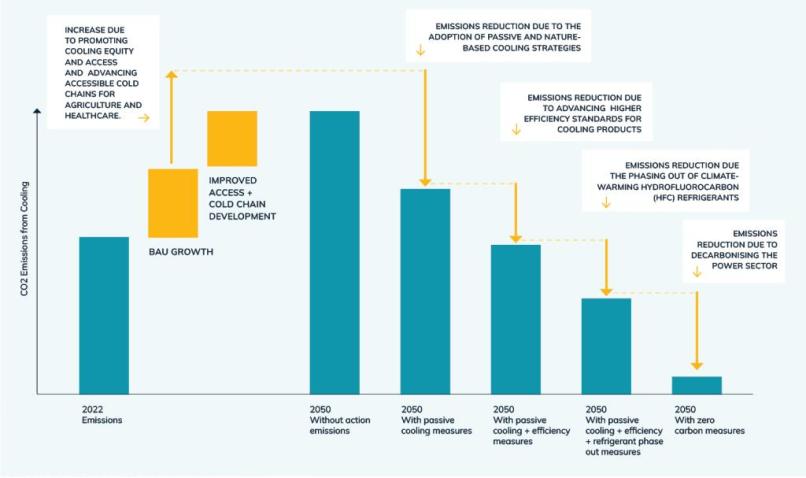Sustainable cooling for all in Kenya
To meet the needs and address challenges across all key cooling sectors in Kenya and achieve sustainable cooling for all, integrated action and cross-cutting interventions are necessary across six key themes:
- Passive and nature-based cooling strategies, such as climate-responsive building design (see the Startup Lions Campus by Kéré Architecture located in Turkana County with it passive cooling features and recommendations for cool schools), nature-based solutions for cities (see Miti Mitaani, a community-initiative that engages youth in planting and maintaining trees along the Nairobi River basin to cool urban areas and build climate resilience), and pot-in-pot refrigerators, also known a Zeer pots, that use evaporative cooling to preserve food without electricity.
- Improve energy efficiency for key cooling appliances –– fans, refrigerators, freezers and air-conditioning –– through periodic revisions to minimum energy performance standards (MEPS), and optimize cooling operations through smart controls and automation, and behaviour change, such as operating higher internal cooling set points.
- HFC refrigerants phase down in line with the Kigali Amendment commitments and phasedown schedule. This includes reducing global warming potential of refrigerants in new and existing equipment (e.g. move to CO2-based cooling in supermarkets, enhanced AC MEPS, low GWP limit for AC refrigerants) and preventing HFC emissions from leaking from existing equipment (through checks, servicing and recovery end of life supported by appropriate training and capacity building)
- Decarbonization of the power sector in line with the Kenya Energy Transition and Investment plan that provides a pathway to meet Kenya’s growing electricity demand and reach net zero carbon emissions from the power grid by 2050 through significant deployment of solar PV, nuclear unit deployment starting in 2045 and production of green hydrogen ramping up significantly starting in 2040.
- Promote cooling equity and access to address the fundamental objectives of Sustainable Development Goals 1 (No Poverty), 7 (Affordable & Clean Energy) and 10 (reduced inequality) so communities have the resources to access affordable, safe, and reliable cooling. The relationship is mutual since access to cooling helps alleviate poverty and reduce inequality by improving health, productivity, and income opportunities. Efforts must focus on reaching the most vulnerable, e.g. adopting community-based ‘cool roof’ initiatives across informal settlements, and addressing equity issues including gender-related challenges (see Cooling for All and Gender: Towards Inclusive, Sustainable Cooling Solutions).
- Develop and scale accessible cold chains for agriculture and healthcare that support economic development and strengthen food security and health outcomes in rural communities. This includes adopting sustainable technology and services such as cooling-as-a-service provided by SokoFresh and VacciBox. Scaling and development can build on the African Centre for Technology Studies (ACTS) knowledge centre focused on sustainable cooling and cold-chain solutions, which is also known as a Specialized Outreach and Knowledge Establishment (SPOKE) of the Africa Centre of Excellence for Sustainable Cooling and Cold-Chain (ACES).

Recommended priority areas for policy and market interventions to achieve sustainable cooling for all in Kenya by threading these six themes together to help accelerate a just and equitable cooling transition are given on the next page.
Sustainable cooling solutions can be explored on the #This is Cool web site.

Figure 9: Sustainable Development Goals & Cooling in Kenya